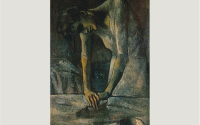Phillips Launches Direct-from-Artist Sale Platform, Expanding into E-Commerce
Phillips has launched Dropshop, a digital platform that aims to bring limited-edition artworks and collectibles commissioned from living artists directly to collectors. For the auction house, the move is a step toward expanding into e-commerce.
The first artist commissioned to produce works offered through the platform is Australian-born, Brooklyn-based artist Cj Hendry. One hundred bronze inflatable crowns produced by the 35-year-old artist, whose drawings and sculptures have gained her a following online, will be released on August 20 when the platform first goes live. Prices for the works have not yet been disclosed.
The promise of receiving 3 percent from any resales of their art at Phillips is one draw for artists working with Dropshop.
Because resale royalties are not standard among auction houses, Phillips is aiming to make the model an industry first. Sales of the editioned works from other artists contracted to make work for the platform will be released monthly. The terms of the participating artists’ contracts with Phillips are being kept confidential.
Increasingly, artworks sold directly from artist’s studio have been included in contemporary art day sales at Phillips, as well as at auctions held by competing houses such as Sotheby’s and Christie’s.
Hendry, whose Instagram boasts 682,000 followers and who attributes her commercial success to the app, already sells commissioned works directly from her namesake studio. Despite having had solo shows in galleries, she does not maintain representation with dealers—an unconventional move for an artist her age.
In a statement, Christine Miele, Phillips’s newly appointed retail sales director, acknowledged that the new platform responds to shifting dynamics in the market. Some artists, she said, are increasingly relying on “self-representation.” Since the pandemic’s onset in 2020, collectors have increasingly bought works from emerging artists without commercial representation via social media.
“This has certainly been relevant to the creation of Dropshop,” Miele added.
Before coming to Phillips, Miele headed the Kehinde Wiley Shop, a merchandise platform launched in 2020 by its namesake artist to raise funds for a Dakar-based nonprofit that he runs.
There are currently few other models like Dropshop at competitor auction houses. When works are offered by artists’ studios at auction, the funds gained from sales generally benefit nonprofits or cultural institutions. Last September, for example, Sotheby’s launched a charity-focused primary market platform that allows artists to sell works directly to buyers.
“Over the past few years, artists have expressed an increased importance in both communicating directly with their audience and in playing a more active role in their secondary markets,” Miele said. “In developing the platform, we wanted to rethink how the traditional model for an auction house might be expanded.”
Competing art sale platforms with similar digital models include Avant Arte and Exhibition A, founded in 2021 and 2010, respectively.
While a Phillips spokesperson did not specify who would participate in Dropshop going forward, the representative did say that the house was seeking “blue-chip,” “self-represented” artists.



